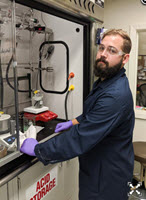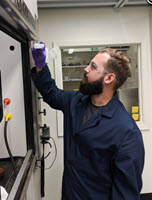
Because oil and water don’t mix easily, oil droplets in the ocean environment tend to aggregate into larger masses, which hinders microbial degradation. Chemical dispersants used for oil spill response contain water-soluble and oil-soluble components that adhere to oil droplets and increase the oil and water’s compatibility, allowing oil to disperse more easily into the water column and enhancing microbial consumption. However, because chemical dispersants require constant energy input from waves, wind, and currents to keep the oil dispersed, they typically only slow oil’s coalescence rather than prevent it.
Chris Keller is developing a dispersant system that combines silica nanoparticles and polymer surfactants and doesn’t require energy input to generate stable oil emulsions. His goal is to identify which combination of these compounds will maximize oil entrapment and dispersion while minimizing harm to marine life.
Chris is a Ph.D. student with Tulane University’s Department of Chemistry and a GoMRI Scholar with the project Designing Nanoparticle-Based Dispersants with Improved Efficiency and Biocompatibility.
His Path

Chris’s interest in science began with his Mandeville, Louisiana, high school chemistry teacher, whose passion for science and its ability to change the world inspired him. He discovered a knack for scientific research while performing basic lab experiments, often modifying the experimental conditions for efficiency. His interest in chemistry eventually evolved into a passion for polymer science.
As an undergraduate polymer science student at the University of Southern Mississippi, Chris investigated the drug delivery applications of different biopolymers in Dr. Daniel Savin’s polymer science lab. He recalls assisting Kyle Bentz, who was then a graduate student in the lab, with his GoMRI-funded research on nanoparticle-based oil dispersants. The research held great significance to Chris, who is from the Louisiana coast, where oil spills and chemical dispersants can affect the local ecosystem and marine life for years. “When I was accepted to Tulane University as a Ph.D. student, little did I know that I would be continuing that same GoMRI research under the direction of Dr. Scott Grayson,” said Chris. “By researching alternative methods to cleanup oil spills, I feel that I am contributing to measures that can help lessen their impacts and ensure that an oil spill isn’t a defining event for a region’s ecosystem.”
His Work
Chris is continuing the research of Dr. Kyle Bentz and Dr. Muhammad Ejaz investigating polymer-modified silica-based nanoparticles as a new system of oil dispersants. Chris’s team hypothesizes that once the nanoparticle system entraps the oil, the oil’s density will change so that it floats to the ocean surface for collection via skimming. This process could be repeated as many times as necessary to help spill response efforts. Chris is designing the nanoparticle system and observing the nanoparticles’ reactions with unimolecular micelles (single-molecule surfactant polymers that don’t require energy input to generate stable oil emulsions).

The nanoparticle system is made up of a silica-based core with a copolymer chain attached to it that contains both hydrophobic (oil-soluble) and hydrophilic (water-soluble) polymer molecules. The hydrophobic polymer drives the entrapment of oil while the hydrophilic polymer helps disperse the oil into the water column. Chris has found that there is a delicate balance between the ratio of these two polymers that dictates if the system will exhibit the right properties for real-world application. For example, too many hydrophobic molecules could trap oil too quickly, changing the oil’s density so that it rises to the surface earlier than desired, but too many hydrophilic molecules could slow the rate of oil entrapment and reduce the amount of oil that disperses. Too many polymer molecules overall could create particles that are too large to effectively disperse the oil and may affect marine organisms.
So far, Chris has observed preliminary evidence of oil entrapment and established the minimum number of hydrophilic molecules required to disperse the oil particles in water (up to tens of milligrams per milliliter of water). He is currently adjusting the ratio of hydrophobic and hydrophilic molecules to identify combinations that will return the same or better results. To do this, he tests various nanoparticle-micelle mixtures under an inert (not chemically active) nitrogen atmosphere and observes their reactions over time. He examines if simple shaking will disperse the modified particles in water and, if so, records what concentrations are needed to prevent the particles falling to the bottom of the test vial. Each reaction’s success is determined by the amount of polymer that effectively attaches to the nanoparticle surface. He uses a centrifuge to isolate the nanoparticle system and collect the free polymers that did not attach during the reaction. Analyzing the unattached polymers can provide a rough approximation of the size of the polymers that attached to the nanoparticle surface.

Chris sends batches of different polymer-modified nanoparticles to collaborating labs to be analyzed for toxicity and effectiveness in entrapping oil. He constantly adjusts his experimental set up based on his colleagues’ findings on the different formulations. “At the end of the day, it’s about a real-world application. Their results help me adjust the polymer makeup to find a system that will meet our goal: the most oil entrapment with the least environmental impact,” explained Chris. “Furthermore, Dr. Savin’s lab at the University of Florida is developing a different polymer-modified nanoparticle system to test against mine to see which one yields better results.”
Once the new dispersant system’s design is complete, Chris will fine-tune the system so that industry can scale it up for real-world application. While the system is being developed with oil spill mitigation in mind, there are other potential uses of the team’s nanoparticle dispersant system. “Future applications other than dispersants are going to largely depend on how ‘biofriendly’ we can make these,” explained Chris. “For example, an undergraduate student working on his senior thesis under my guidance is examining the use of sugar-based nanoparticles. If we can utilize a different core such as sugar instead of silica, I think we could potentially see some use as drug carriers or filtration devices later down the line.”
His Learning
Dr. Grayson taught Chris to take his research one goal at a time and emphasized collaboration’s important role in achieving those goals. Being a part of the GoMRI community keeps Chris mindful of the broader implications of his research. For example, Chris’s close focus on his laboratory research sometimes caused him to forget that, while his research has applications for oil spill response, research contributing to other applications is just as important. “When I go to the Gulf of Mexico Oil Spill and Ecosystem Science conference, I get to see the other researchers’ perspectives first-hand and consider things that I wouldn’t have thought about on my own,” he said. “It makes me a more well-rounded researcher.”
As Chris nears graduation, he prepares his research for the next cohort of graduate students to continue. “Science is a marathon, not a sprint, and is met with a lot of ‘brick walls’ and frustration,” said Chris. “Having patience, taking a step back, and looking at it from different perspectives [makes it possible to] change the world one small victory at a time. The experiments won’t always work, but that’s the point of research.”
Praise for Chris
Dr. Grayson praised how Chris tested the team’s theory that silica nanoparticles modified with surfactant polymers could successfully stabilize oil mixtures in water. He explained that Chris’s experiments built upon previous research to include more oil dispersion processes and remove high temperatures associated with synthesizing the polymers and nanoparticles. “Chris has done a great job working on this theory,” said Dr. Grayson. “It appears in these last few months that he will finally achieve everything that we had hoped for: an environmentally friendly, non-toxic oil dispersant.”
The GoMRI community embraces bright and dedicated students like Chris Keller and their important contributions. The GoMRI Scholars Program recognizes graduate students whose work focuses on GoMRI-funded projects and builds community for the next generation of ocean science professionals.
By Stephanie Ellis and Nilde Maggie Dannreuther. Contact sellis@ngi.msstate.edu for questions or comments.
************
The Gulf of Mexico Research Initiative (GoMRI) is a 10-year independent research program established to study the effect, and the potential associated impact, of hydrocarbon releases on the environment and public health, as well as to develop improved spill mitigation, oil detection, characterization and remediation technologies. An independent and academic 20-member Research Board makes the funding and research direction decisions to ensure the intellectual quality, effectiveness and academic independence of the GoMRI research. All research data, findings and publications will be made publicly available. The program was established through a $500 million financial commitment from BP. For more information, visit http://gulfresearchinitiative.org/.
© Copyright 2010-2019 Gulf of Mexico Research Initiative (GoMRI) – All Rights Reserved. Redistribution is encouraged with acknowledgement to the Gulf of Mexico Research Initiative (GoMRI). Please credit images and/or videos as done in each article. Questions? Contact web-content editor Nilde “Maggie” Dannreuther, Northern Gulf Institute, Mississippi State University (maggied@ngi.msstate.edu).
